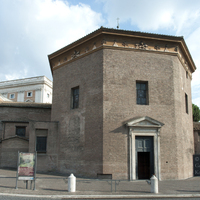Lateran Basilica and Baptistery
Type:
Baptisteries,
Churches
Date:
First half of the fourth century
Location or Findspot (Modern-Day Country):
Italy
Dimensions:
Approximately 20 m in height and 20 m in width
Description:
Constantine (r. 306–12), the first Roman emperor to recognize Christianity, was the founder of Rome's cathedral. This basilica, dedicated to Christ the Savior, was later called San Giovanni in Laterano (the Lateran). It was built on the east side of the Caelian Hill and was the first great church within Rome's city walls. Unlike most medieval churches, its semicircular apse projected to the west rather than the east, in part for topographic reasons and perhaps also to imitate the orientation of the Temple in Jerusalem. The nave had four aisles, with the outer ones lower than the inner ones. There were reused red granite columns lining the nave and reused green marble columns in the aisles. Among Constantine's donations of vestments, vessels, and other decorations for the cathedral was the now-lost fastigium, a monumental silver ciborium for the main altar. The adjacent Lateran Baptistery is preserved, but almost nothing remains of the fourth-century Lateran Basilica.
Constantine's octagonal baptistery, also known as San Giovanni in Fonte (St. John of the Font), was built northwest of the basilica. This centralized structure reused the plumbing of an earlier bath complex and originally had a low font. Tradition holds that it was the site of Constantine's baptism by Pope Sylvester I in 324, at the end of Constantine's life. Many baptisteries that came after, as well as manuscript images of the fountain of life, took inspiration from the octagonal design of Constantine's structure. According to the sixth-century Liber Pontificalis (Book of the Popes), Constantine donated to the baptistery a gold statue with the the Lamb of God and seven silver stags drinking from the font and serving as waterspouts.
Constantine's octagonal baptistery, also known as San Giovanni in Fonte (St. John of the Font), was built northwest of the basilica. This centralized structure reused the plumbing of an earlier bath complex and originally had a low font. Tradition holds that it was the site of Constantine's baptism by Pope Sylvester I in 324, at the end of Constantine's life. Many baptisteries that came after, as well as manuscript images of the fountain of life, took inspiration from the octagonal design of Constantine's structure. According to the sixth-century Liber Pontificalis (Book of the Popes), Constantine donated to the baptistery a gold statue with the the Lamb of God and seven silver stags drinking from the font and serving as waterspouts.
Relevant Textbook Chapter(s):
2
Repository and Online Resources:
• Read about digital mapping and 3D visualization techniques at the Lateran Basilica.
• For more views of the baptistery, visit the Kornbluth Photography website.
Image Credits:
Genevra Kornbluth, Navid Jamali



